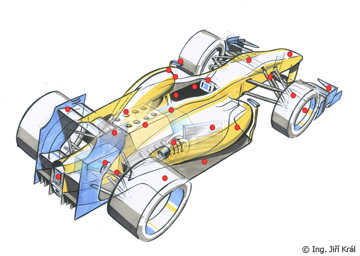The Chinese GP according to Brembo An in-depth look at Formula 1 brake use on the Shanghai circuit
Alessandra Fedeli/ Brembo | 17.4.16 | Brembo F1 brzdy
Brembo F1 2016
The Chinese GP according to BremboAn in-depth look at Formula 1 brake use on the Shanghai circuitThe Shanghai International Circuit will host the 3rd race of the 2016 Formula 1 WorldChampionship season from 15 to 17 April.The track, created by architects Hermann Tilke and Peter Wahl, is designed along the linesof the Chinese Shang character. A straightaway measuring 1,397 metres has the singleseatersgoing full throttle for 56 percent of each lap, while the five second-gear curvesrequire a high aerodynamic downforce. The kit on the single-seaters falls therefore half-waybetween the two extreme cases, favouring braking action so that the aerodynamicresistance facilitates deceleration.According to Brembo technicians, who classified the 21 World Championship tracks on ascale of 1 to 10, the Shanghai International Circuit is in the category of circuits that presentmid-level difficulty for the brakes.
The Shanghai track earned a score of 6 on the difficultyindex, which is identical to what the Barcelona track and the new track in Mexico City scored.Brake use during the GPThe time spent braking, 18% of the overall duration of the race, is the lowest amongst thefirst seven races in the 2016 championship. The average deceleration is 3.4 g, which islower than 15 percent of the values for the races contended in Australia and Bahrain. As forenergy dissipated in braking, the Shanghai International Circuit slides into the third lastposition amongst the World Championship circuits: during a race, a car dissipates anaverage of about 97 kWh in energy while braking, a figure that is equivalent to the amountof electric energy a Tanzanian resident consumes in a year. Furthermore, throughout therace each driver has to brake approximately 450 times, applying a total force on the pedalthat surpasses 51 tonnes, or 10 times the weight of an average-sized elephant.The most challenging stopsOf the eight braking sections on the Shanghai International Circuit, two are classified ashard on the brakes, four are of medium difficulty and two are light.
The most challenging braking section, meaning it nearly reaches 5 g, is curve 14 where thedrivers arrive at more than 330 km/h, so they have to apply a load of 183 kg on the pedal inorder to go down to 61 km/h in just 1.74 seconds. In terms of g, the first curve (4.6 g) doesn'tmess around either, but the speed is reduced only by half: from 320 to 158 km/h.The four braking sections of medium difficulty still demand a downforce on the pedalmeasuring between 104 and 132 kg; not a stroll in the park.
The least challenging braking section is the hairpin turn at curve 3, where the cars arrive atjust over 120 km/h and the drivers only have to brake for 20 metres to set the curve.Brembo VictoriesIn China, Brembo has won 8 out of 12 races contended up to today, including the last four,three of which were with Mercedes. Ferrari however, boasts four victories. In China,Sebastian Vettel won his first race with Red Bull in 2009. Lewis Hamilton, with Brembo, tookfirst place twice in Shanghai.




